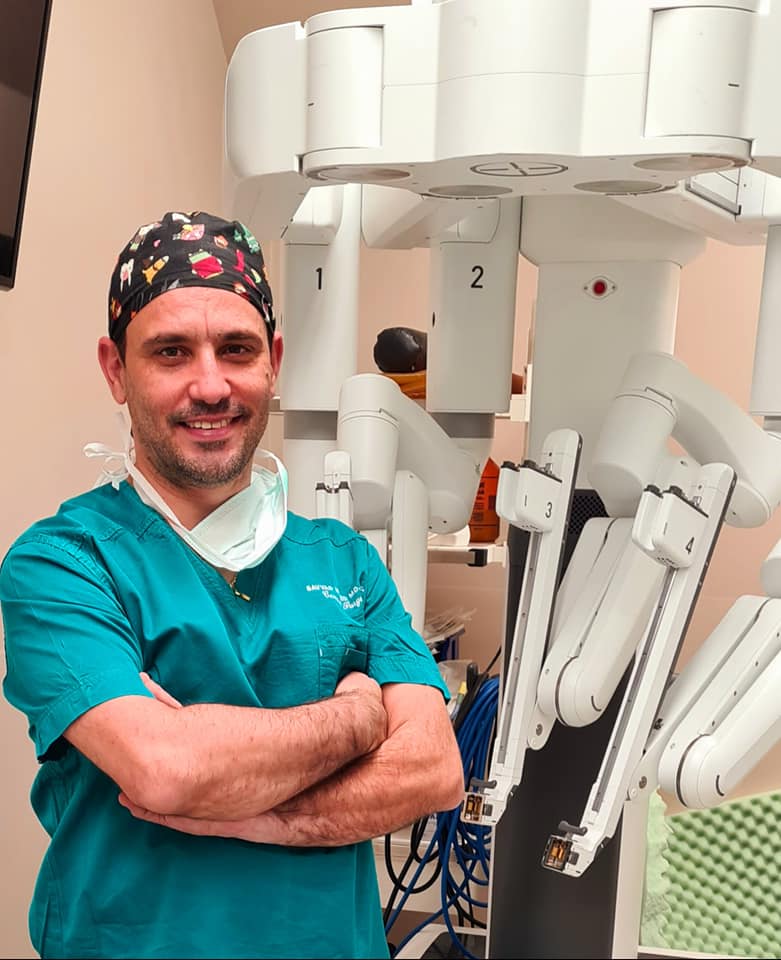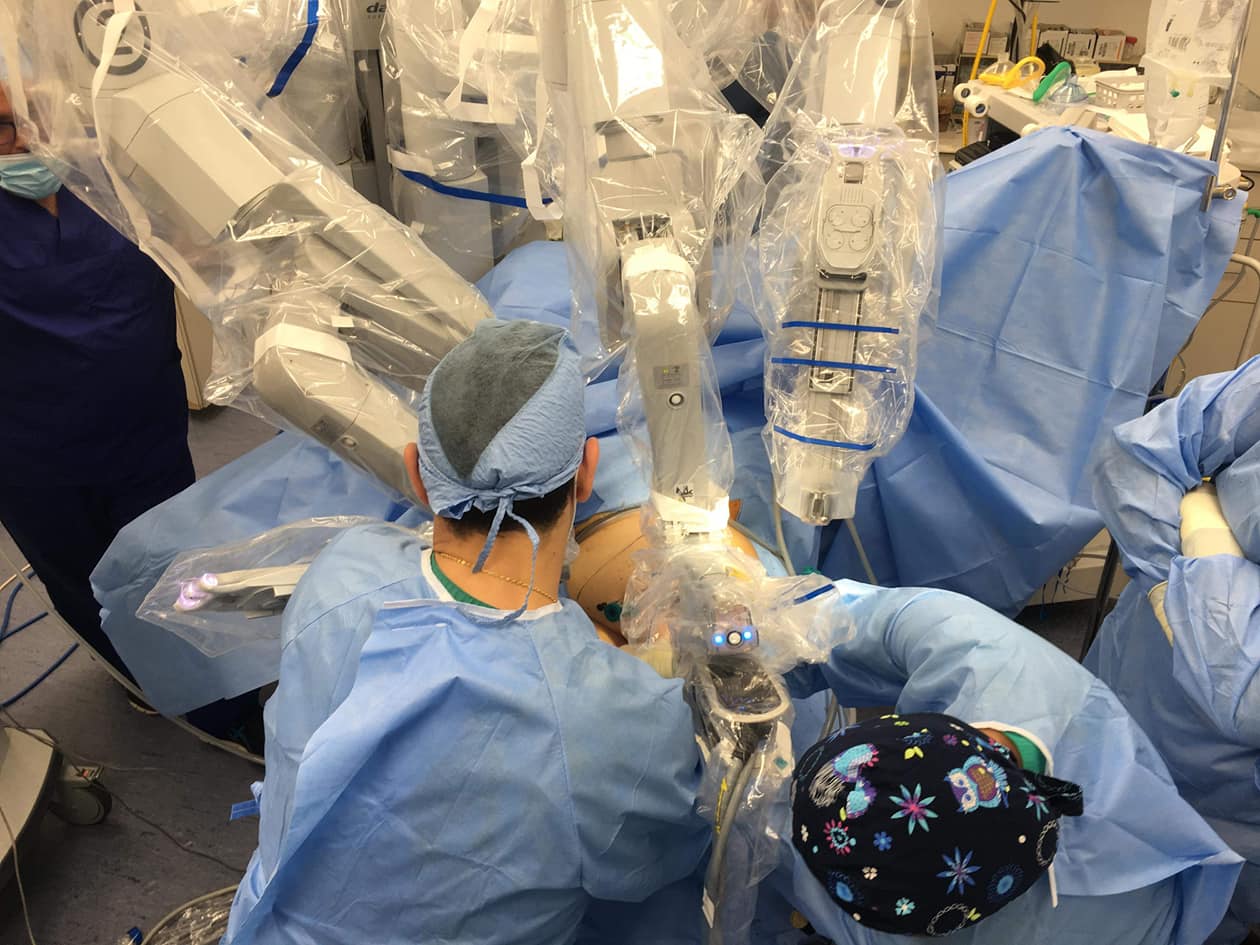ROBOTIC SURGERY

Dr. Chiridis has worked in the First Robotic Surgery Program in the country since January 2007, at the Athens Medical Center and has experience with the use of all systems (daVinci standard, daVinci S, davinci Si, Davinci Xi & da Vinci Single-Site) . Today he gathers experience from 3900 surgeries (1100 robotic, 1600 laparoscopic and 1200 classical open surgery and laser surgeries).
-------------------------------------------------- -------------------------
Robotic Surgery is the evolution of laparoscopy and is the latest technology (state of the art) in surgery. Overcoming the limitations of conventional laparoscopic surgery, robotics brings the computer between a surgeon and a patient for the first time .
The surgical robot consists of the control console and the robotic arms. The surgeon sits comfortably on the console from where he can see three-dimensionally inside the abdomen with special stereoscopic glasses and control the arms and robotic tools with special controls (masters). The main advantages of robotics are the three-dimensional display (high definition / high definition, without the need for focus / focus-free) of the surgical field and the great ease (7 degrees of freedom) of movements of the robotic arms, similar to those of the "human wrist" (endowrist instruments) and offer high-precision manipulations in narrow abdominal cavities. also Intra-abdominal suturing is greatly facilitated , while the control of the operation passes entirely to the surgeon.

In addition, robotics offers the safest platform for single-site surgery , which minimizes trauma and offers an excellent aesthetic result. It is worth noting that Dr. Chiridis had the pleasure of being in the team of surgeons (Greece, Italy and Switzerland) who were the first in the world to be trained in this technique, in January 2011 in Strasbourg, and since then he has been applying the technique in Greece, at the Medical Center. Athens. The evolution of that first Single Site VESPA system led to a completely new robotic system introduced in 2018 in America under the name da Vinci Sp.

The latest generation of surgical robot da Vinci SP for operations through a single incision
New tools with state-of-the-art technology and advanced surgical energy generators (cauterization and vasoconstriction) are added daily to the quiver of robotic systems. Such recent developments are: the bipolar cauterization technology of vessels up to 5mm in diameter that completes the ligation in less than 2 seconds (Synchroseal) , the articulated bipolar forceps for vessels up to 7mm in diameter with the possibility of simultaneous excision with automatic Sender knife and Extender knife ) forceps that capture the tissues by applying adjustable pressure of two options (Force Bipolar with Dual Grip) . At the same time, the manufacturers' new response to energy , the E-100 generator"seals" the vessels in half the time of its predecessors. In recent years, robotic staplers with controlled closing pressure and electronic ensuring correct firing to avoid complications have come into the halls . And of course, thanks to the daVinci Xi auxiliary arm and its communication with the operating table (Integrated Table Motion) , the need to disconnect and redock the system when there is a need to change the position of the patient or the system has been completely eliminated.
Robotics allows the patient to use examinations intraoperatively as a navigation tool through the TILE-PRO system. The surgeon may consult CT and MRI scans or other examinations during the operation. The use of these graphic models in combination with the real image of the operating room provides the surgeon with important information for the safe completion of the operation and marks the beginning of the era of "Augmented-Reality Surgery". The Medical Robotic Surgery team, at the initiative and design of Dr. Chiridis, used for the first time in the world, three-dimensional reconstructions of the patient's anatomy from axial angiography forIntraoperative Navigation within the Robotic System with e-film (PC) and Osirix (Mac) software . This international avant-garde was successfully presented at the 2010 MIRA World Conference on Robotic Surgery in San Diego. Today it is included in the capabilities of the new systems in which it is used with the Iris software.
New technologies of intraoperative navigation, augmented reality and artificial intelligence promise to lead Robotic Surgery to the next era of Artificial Intelligence (Artificial Intelligence / Surgery 4.0).
The already numerous indications of robotic telesurgery in urology (remarkable spread of robotic radical prostatectomy), in general surgery, in gynecology, cardiac surgery, and pediatric surgery are increasing daily.
Today, using robots, Dr. Chiridis and his team perform daily operations on hernia, abdominal hernia, septal hernia, bile, stomach, small and large intestine, abdominal tumors, intra-abdominal adhesions and intestinal obstruction - chronic pain, and chronic pain. type 2 (metabolic surgery). One-sided robotic surgeries (eg Single Site cholecystectomy) have been performed since 2011, exclusively by the team of the Athens Medical Center in Greece and Cyprus.
(text automatically translated from Greek)
Last Article Update: March 2021
